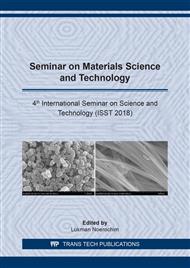p.180
p.185
p.193
p.199
p.209
p.215
p.221
p.228
p.234
Study of pH Effect on the Anaerobic-Aerobic Fermentation of Siwalan (Borassus flabellifer L.) Sap to Produce Acetic Acid
Abstract:
Siwalan (Borassus flabellifer L.) is a palm family that is widely planted in the Tuban area of East Java. Siwalan sap has a relatively high sugar content of about 10-15 g / 100 ml. The sap is obtained by tapping the inflorescences. In general, siwalan sap is used for fresh drinks or alcoholic beverages with maximum storage in 3 days. Based on the sugar content in the sap of siwalan, acetic acid products can be made through fermentation of glucose to ethanol, then the ethanol is fermented into acetic acid. Acetic acid is widely used as a preservative of food and health drinks. The purpose of this research is to study the effect of ethanol fermentation aerobic pH on acetic acid product. Anaerobic fermentation uses saccharomyces cereviceae to produce ethanol, and aerobic fermentation uses acetobacter aceti for acetic acid production. In aerobic ethanol fermentation using pH 3; 3.5; 4 and 5. The concentration of ethanol was analyzed using GC ULTRA Scientific Gas Chromatography, DSQ II detector, and MS 220 column. Acetic acid produced from the aerobic fermentation process was analyzed using an alkalimetric method. Anaerobic fermentation uses Saccharomyces cereviceae with 1-day log phase, while aerobic fermentation uses acetobacter aceti with a 5 day log phase. Aerobic fermentation to produce acetic acid was observed in 5 days to obtained maximum acetic acid concentration, the highest acetic acid concetration is about 2.595 g/l and yield of acetic acid is obtained 0.519% (b/v) at pH 5. Low acetic acid concentration due to low intitial sugar content in siwalan sap.
Info:
Periodical:
Pages:
209-214
Citation:
Online since:
July 2019
Keywords:
Price:
Сopyright:
© 2019 Trans Tech Publications Ltd. All Rights Reserved
Share:
Citation:


